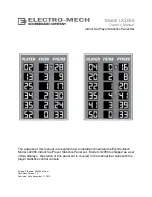
REGULAR MAINTENANCE OF YOUR L&L KILN
maintain.pdf
REV: 11/1/2016
Page 1
2016
L&L Kiln Mfg, Inc. 505 Sharptown Rd, Swedesboro NJ 08085 P:856.294.0077 F:856.294.0070 [email protected] hotkilns.com
WATCH THIS VIDEO
This video shows you the basics of how to do routine
maintainence on your L&L kiln:
hotkilns.com/maintaining-kiln
REGULAR KILN MAINTENANCE
To keep your kiln in top operating condition, we recommend
the following minimum housekeeping:
AFTER EACH FIRING
1) Turn off the kiln at the circuit breaker or fused disconnect
switch.
2) Check element holders and walls for glaze, clay chips or
anything that could melt at a high temperature. If melted
clay or glaze comes in contact with an element, a rapid
failure could result. The molten material traps the heat
radiating from the element and subsequently raises the
surface temperature of the wire. The temperature will
quickly pass the maximum recommended for the wire and
burn it up. To clean holders, a good shop vacuum with
a HEPA filter will handle dust and loose crumbs. A very
gentle chisel or grinder may help with glaze contamination
on element holders, but remember that the elements
themselves are quite brittle when they are cool. Replace
the contaminated holder if you can not clean it. Remove
any glaze that has splattered on the firebrick or shelves.
(CAUTION: USE SAFETY GLASSES WHEN DOING THIS
BECAUSE GLAZE CAN BE LIKE BROKEN GLASS).
Vacuum afterward.
VACUUMING NOTE: It is possible to build up a strong
static electricity charge when you are vacuuming. If this
somehow manages to discharge into the control it can ruin
the electronic circuit. Make sure the vacuum is grounded
and periodically touch some grounded metal surface away
from the kiln to discharge the energy.
3) Make sure the tops of the shelves are coated with kiln
wash as it will keep running glaze from ruining the shelf.
Some people also apply the kiln wash to the kiln bottom.
Because this has both its benefits and detractants, we
recommend that it only be done based on the kiln user’s
individual preferences. (Do not coat the undersides or the
sides of the shelves because you do not want the kiln wash
to fall off into the kiln).
4) Keep a kiln log of firings. Tracking the performance
of your kiln over time may turn out to be an extremely
valuable tool if you ever need to diagnose future problems.
Remember that you can easily get the firing time and final
temperature at the end of the firing by hitting the Prog
Review button if you have a DynaTrol.
CAUTION: KILN WASH AND CLAY CONTAIN
SILICA
1. Long term exposure to silica dust could cause lung
damage.
2. See the MSDS sheets.
3. Exercise proper caution when mixing the dry powder
and when removing it from your shelves.
4. Use a NIOSH approved particulate respirator for dust
and use proper ventilation. You can buy these from
safety supply houses. (NIOSH_approval #TC-21C-132
is an example).
AFTER 10 FIRINGS
1) Check temperatures of the main power cord at the main
receptacle and the main kiln breaker while the kiln is at its
hottest. If these are hotter than normal, it could be a sign of
a loose or corroded connection, or possibly the wire gauge
used in the power hook-up is the wrong size for the amount
of current being drawn by the kiln. Immediately diagnose
and fix this because it could cause a fire.
2) If you have a plug on your kiln, unplug it from the
receptacle and check for oxidation, any burn marks,
discoloration, or melted spots on the plug. If you see this
replace the plug (and the receptacle) before using the kiln
again. Make sure the receptacle feels tight when you press
the plug into the outlet. A loose receptacle indicates worn
springs, which will lead to overheating.
NOTE:
An oxidation inhibitor can be used on the plug’s
prongs.
3) Check element resistance. You will need a digital
multimeter (see the Troubleshooting Guide). Keep track of
this information.
4) Check tightness of case and retighten if necessary. (the
case will expand and contract during each firing and may
eventually become loose. Brick also shrinks slightly with
















































